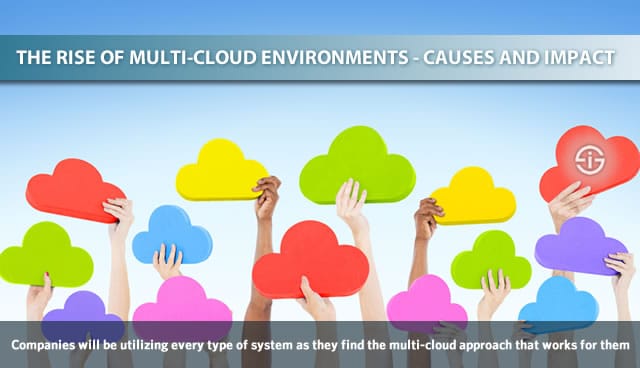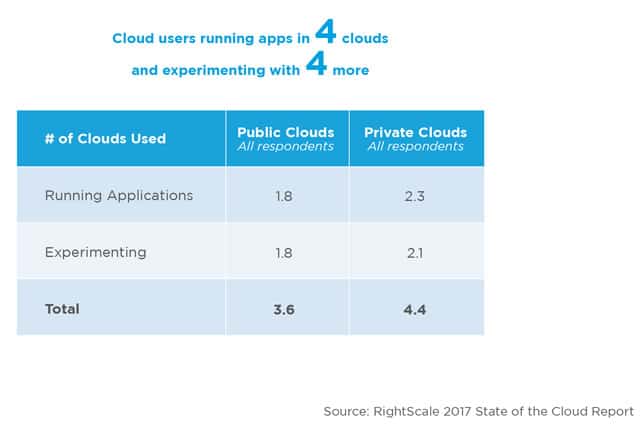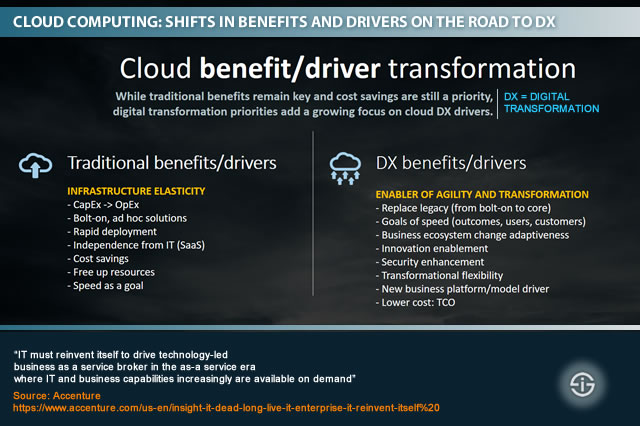For many years now adoption of cloud computing is rising. However, since a few years there is a change in the “why” and “how” the cloud is deployed in organizations in an increasing multi-cloud reality, with hybrid cloud as the dominant cloud delivery model although public cloud adoption is rising fast, also for mission-critical workloads.
Whereas traditionally businesses – and vendors – used to focus most of all on lowering capital costs (CapEx to OpEx, pay-per-use) and scaling, there is a shift in the reasons of cloud adoption towards the business advantages of the cloud in a digital transformation and digital business context. The increasing number of reasons to move to the cloud goes beyond the aspects of cost savings, speed, responsiveness, the possibility to bypass slow processes and agility.

While the traditional advantages do remain, they are joined by a range of reasons to go cloud that are ever more about the speed and changing reality of business. Shortening the time to market, using the cloud as a way to meet the requirements – and thus workloads – of business departments (increasingly the de facto key decision makers in many IT domains) and the possibility to upscale, downscale and move workloads or applications in a cloud that fits the innovation, transformation and business requirements best. That is the “why” of the shift in cloud deployments.
The “how” of cloud: a hybrid, multi-cloud enterprise IT reality
At the same time there is the mentioned evolution in the “how”. For years, organizations pondered whether (and where) they should move to the cloud. Today they are simply doing so, sometimes without knowing it, de facto living in a multi-cloud reality whereby they have a range of clouds for various purposes.
This has an impact on the role of enterprise IT and even the CIO. It also impacts the ways vendors approach potential and existing customers. Do note that there is a difference between hybrid cloud and multi-cloud setups.
There is a lot of research indicating how the use of multiple clouds within an organization is growing. In fact, if we take into account the de facto usage of cloud services by specific workers and business departments, outside of IT, a lot of companies are already multi-cloud. But that’s not the only thing we mean here. Multi-cloud is becoming a deliberate choice and, in fact, an enabler of choice. In more than one sense the evolution towards multiple clouds – and the hybrid cloud – is even a logical evolution.
End 2016 Forrester stated that, while organizations already use multiple clouds, they will do so even more in 2017 (and let’s add “beyond”) with CIOs stepping up to orchestrate the various cloud ecosystems connecting employees, customers, partners, vendors and – with the Internet of Things in mind – devices to serve rising customer expectations.
And there is more: according to the Forrester predictions (PDF opens), enterprises won’t just having an increasingly multi-cloud reality to orchestrate, they’ll become cloud companies themselves, something we, among others, see with big Industry 4.0 players such as GE and Bosch to quote the two Forrester refers to.

How organizations move to a multi-cloud environment
A few vendors we spoke with expect that within a few years 90 percent of organizations will have a de facto multi-cloud environment.
Companies will be utilizing every type of system as they find the multi-cloud approach that works for them
These evolutions aren’t new. The data we hear correspond with older data from CompTIA, the IT Industry Trade Association. The organization found that more than 90 percent of companies already used some form of cloud computing . CompTIA indicated that, quote, “companies will be utilizing every type of system as they find the multi-cloud approach that works for them”. The key reason: “no one model is the best answer for every workload”.
This is indeed one of the primary drivers of a multi-cloud reality. No workload and no business requirement is the same. There are always different needs, even if they are sometimes small. The requirements of the typical first mover in cloud-based environments, marketing, are not the same as those of other departments, to give just one example.
In its Worldwide Cloud 2017 Predictions, IDC predicted that over 85 percent of enterprise IT organizations will commit to multicloud architectures by 2018, driving up the rate and pace of change in IT organizations.
Another piece of research in the context of multiple clouds is OVUM’s “Realising possibilities in the cloud: The need for a trusted broker”, sponsored by Cisco and BT (a partner). The paper focuses on a fundamental shift in cloud purchasing and mentions how more than 40 percent of European organizations enterprises expect to manage a hybrid multi-cloud environment within the next two years (since the research was conducted). Note the word European.

At the bottom of this post is an infographic, summarizing some key takeaways from the report and tackling the move to a hybrid multi-cloud environment and some challenges to tackle.
Impact of the multi-cloud evolution on enterprise IT and the CIO: the orchestration role
Regardless of all this data, we effectively see a de facto rapid growth of multi-cloud environments. Again, this is partially logical and a consequence of, among others, growing experience with the cloud, business demands and the need for greater transparency and agility by several IT professionals which is being met with cloud management solutions whose function really is to enable transparency and the facilitation of the role of IT and the CIO, regardless of the multi-cloud reality, in a seamless way so they can focus on supporting business requirements and workloads. And of course and last but not least there is the awareness that without the cloud there simply is no digital transformation. Given that no single cloud fits all purposes in digital business requirements it’s obvious that the multiple clouds reality continues to grow.
As mentioned, the growing role of business in the whole equation and the changes in who buys solutions (decreasingly IT, increasingly business unitis), affects the role of enterprise IT and the CIO. In 2016 analysis, Accenture went as far as to say that IT must reinvent itself to drive technology-led business as a service broker in the “as-a service era” where IT and business capabilities increasingly are available on demand. More about that in Accenture’s “IT is dead. Long live IT. Why enterprise IT must reinvent itself.“.
What’s interesting is that brokerage role. We also have seen it popping up in the cloud services market as such. But just as many cloud brokers are moving from a cloud services providers and or cloud brokerage function to a cloud integration services and orchestration model, expect IT to become more than a broker but an orchestrator too as Forrester sees them doing more and more.
And, in the end, today’s ‘digital CIO‘ already is a connector, facilitator and orchestrator. Or at least should be.

Top image: Shutterstock – Copyright: Rawpixel.com – All other images are the property of their respective mentioned owners.

